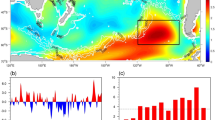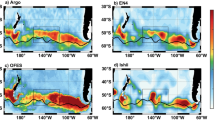Abstract
Seasonal and interannual variability of ocean bottom pressure (OBP) in the Southern Ocean was investigated using Gravity Recovery and Climate Experiment (GRACE) data and a Pressure Coordinate Ocean Model (PCOM) based on mass conservation. By comparing OBP, steric sea level, and sea level, it is found that at high latitudes the OBP variability dominates the sea level variability at seasonal-to-decadal time scales. The diagnostic OBP based on barotropic vorticity equation has a good correlation with the observations, indicating that wind forcing plays an important role in the variability of the OBP in the Southern Ocean. The unique interannual patterns of OBP in the Southern Ocean are closely associated with El Niño-Southern Oscillation (ENSO) and Southern Annular Mode (SAM). Regression analysis indicates that ENSO and SAM influence the OBP through altering the Ekman transport driven by surface wind. The leading pattern of OBP from PCOM are very similar to observations. Sensitive experiments of PCOM show that surface wind forcing explains the observed OBP variability quite well, confirming the importance of wind forcing and related oceanic processes. In the eastern South Pacific, the averaged OBP shows a decrease (increase) trend before (after) 2011, reflecting the reverse trend in westerly wind. In the South Indo-Atlantic Ocean, the averaged OBP has a weak increase trend during 2003–2016.
Similar content being viewed by others
References
Androsov A, Boebel O, Schröter J, et al. 2020. Ocean bottom pressure variability: Can it be reliably modeled?. Journal of Geophysical Research: Oceans, 125(3): e2019JC015469
Antonov J I, Seidov D, Boyer T P, et al. 2010. World Ocean Atlas 2009, Volume 2: Salinity. NOAA Atlas NESDIS 69. Washington, DC: U S Government Printing Office
Bergmann I, Dobslaw H. 2012. Short-term transport variability of the Antarctic Circumpolar Current from satellite gravity observations. Journal of Geophysical Research: Oceans, 117(C5): C05044
Boening C, Lee T, Zlotnicki V. 2011. A record-high ocean bottom pressure in the South Pacific observed by GRACE. Geophysical Research Letters, 38(4): L04602
Boening C, Willis J K, Landerer F W, et al. 2012. The 2011 La Niña: So strong, the oceans fell. Geophysical Research Letters, 39(19): L19602
Brunnabend S E, Rietbroek R, Timmermann R, et al. 2011. Improving mass redistribution estimates by modeling ocean bottom pressure uncertainties. Journal of Geophysical Research: Oceans, 116(C8): C08037
Cabanes C, Huck T, De Verdière A C. 2006. Contributions of wind forcing and surface heating to interannual sea level variations in the Atlantic Ocean. Journal of Physical Oceanography, 36(9): 1739–1750, doi: https://doi.org/10.1175/JPO2935.1
Cazenave A, Dieng H B, Meyssignac B, et al. 2014. The rate of sealevel rise. Nature Climate Change, 4(5): 358–361, doi: https://doi.org/10.1038/nclimate2159
Cazenave A, Henry O, Munier S, et al. 2012. Estimating ENSO influence on the global mean sea level, 1993–2010. Marine Geodesy, 35(S1): 82–97
Chambers D P, Cazenave A, Champollion N, et al. 2017. Evaluation of the global mean sea level budget between 1993 and 2014. Surveys in Geophysics, 38(1): 309–327, doi: https://doi.org/10.1007/s10712-016-9381-3
Cheng Xuhua, Li Lijuan, Du Yan, et al. 2013. Mass-induced sea level change in the northwestern North Pacific and its contribution to total sea level change. Geophysical Research Letters, 40(15): 3975–3980, doi: https://doi.org/10.1002/grl.50748
Dukowicz J K. 1997. Steric sea level in the los alamos POP code—non-boussinesq effects. Atmosphere-Ocean, 35(S1): 533–546
Fasullo J T, Boening C, Landerer F W, et al. 2013. Australia’s unique influence on global sea level in 2010–2011. Geophysical Research Letters, 40(16): 4368–4373, doi: https://doi.org/10.1002/grl.50834
Gill A E, Niller P P. 1973. The theory of the seasonal variability in the ocean. Deep Sea Research and Oceanographic Abstracts, 20(2): 141–177, doi: https://doi.org/10.1016/0011-7471(73)90049-1
Greatbatch R J. 1994. A note on the representation of steric sea level in models that conserve volume rather than mass. Journal of Geophysical Research: Oceans, 99(C6): 12767–12771, doi: https://doi.org/10.1029/94JC00847
Henley B J, Gergis J, Karoly D J, et al. 2015. A tripole index for the interdecadal Pacific oscillation. Climate Dynamics, 45(11/12): 3077–3090, doi: https://doi.org/10.1007/s00382-015-2525-1
Huang Ruixin, Jin Xiangze, Zhang Xuehong. 2001. An oceanic general circulation model in pressure coordinates. Advances in Atmospheric Sciences, 18(1): 1–22, doi: https://doi.org/10.1007/s00376-001-0001-9
Johnson G C, Chambers D P. 2013. Ocean bottom pressure seasonal cycles and decadal trends from GRACE Release-05: Ocean circulation implications. Journal of Geophysical Research: Oceans, 118(9): 4228–4240, doi: https://doi.org/10.1002/jgrc.20307
Kalnay E, Kanamitsu M, Kistler R, et al. 1996. The NCEP/NCAR 40-year reanalysis project. Bulletin of the American Meteorological Society, 77(3): 437–472, doi: https://doi.org/10.1175/1520-0477(1996)077<0437:TNYRP>2.0.CO;2
Li Hong, Xu Fanghua, Zhou Wei, et al. 2017. Development of a global gridded Argo data set with Barnes successive corrections. Journal of Geophysical Research: Oceans, 122(2): 866–889, doi: https://doi.org/10.1002/2016JC012285
Liau J R, Chao B F. 2017. Variation of Antarctic circumpolar current and its intensification in relation to the southern annular mode detected in the time-variable gravity signals by GRACE satellite. Earth, Planets and Space, 69: 93
Locarnini R A, Mishonov A V, Antonov J I, et al. 2010. World Ocean Atlas 2009, Volume 1: Temperature. NOAA Atlas NESDIS 68. Washington, DC: U S Government Printing Office
Makowski J K, Chambers D P, Bonin J A. 2015. Using ocean bottom pressure from the gravity recovery and climate experiment (GRACE) to estimate transport variability in the southern Indian Ocean. Journal of Geophysical Research: Oceans, 120(6): 4245–4259, doi: https://doi.org/10.1002/2014JC010575
Marshall G J. 2003. Trends in the southern annular mode from observations and reanalyses. Journal of Climate, 16(24): 4134–4143, doi: https://doi.org/10.1175/1520-0442(2003)016<4134:TITSAM>2.0.CO;2
Meredith M P, Woodworth P L, Chereskin T K, et al. 2011. Sustained monitoring of the southern ocean at drake passage: Past achievements and future priorities. Reviews of Geophysics, 49(4): RG4005
Ou Niansen, Lin Yihua, Bi Xunqiang, et al. 2016. Baseline evaluation of a pressure coordinate ocean model (PCOM 1.0). Climatic and Environmental Research, 21(1): 56–64
Peralta-Ferriz C, Landerer F W, Chambers D, et al. 2017. Remote sensing of bottom pressure from GRACE satellites. US CLIVAR Variations Newsletter, 15(2): 22–28
Piecuch C G, Quinn K J, Ponte R M. 2013. Satellite-derived interannual ocean bottom pressure variability and its relation to sea level. Geophysical Research Letters, 40(12): 3106–3110, doi: https://doi.org/10.1002/grl.50549
Ponte R M. 1999. A preliminary model study of the large-scale seasonal cycle in bottom pressure over the global ocean. Journal of Geophysical Research: Oceans, 104(C1): 1289–1300, doi: https://doi.org/10.1029/1998JC900028
Ponte R M, Piecuch C G. 2014. Interannual bottom pressure signals in the Australian-Antarctic and Bellingshausen basins. Journal of Physical Oceanography, 44(5): 1456–1465, doi: https://doi.org/10.1175/JPO-D-13-0223.1
Quinn K J, Ponte R M. 2012. High frequency barotropic ocean variability observed by GRACE and satellite altimetry. Geophysical Research Letters, 39(7): L07603
Song Y T, Zlotnicki V. 2008. Subpolar ocean bottom pressure oscillation and its links to the tropical ENSO. International Journal of Remote Sensing, 29(21): 6091–6107, doi: https://doi.org/10.1080/01431160802175538
Stammer D, Tokmakian R, Semtner A, et al. 1996. How well does a 1/4° global circulation model simulate large-scale oceanic observations?. Journal of Geophysical Research: Oceans, 101(C11): 25779–25811
Stepanov V N, Hughes C W. 2006. Propagation of signals in basin-scale ocean bottom pressure from a barotropic model. Journal of Geophysical Research: Oceans, 111(C12): C12002, doi: https://doi.org/10.1029/2005JC003450
Thomson R E, Tabata S. 1989. Steric sea level trends in the Northeast Pacific Ocean: Possible evidence of global sea level rise. Journal of Climate, 2(6): 542–553, doi: https://doi.org/10.1175/1520-0442(1989)002<0542:SSLTIT>2.0.CO;2
Vivier F, Kelly K A, Harismendy M. 2005. Causes of large-scale sea level variations in the Southern Ocean: Analyses of sea level and a barotropic model. Journal of Geophysical Research: Oceans, 110(C9): C09014
Wang Juan, Wang Jing, Cheng Xuhua. 2015. Mass-induced sea level variations in the Gulf of Carpentaria. Journal of Oceanography, 71(4): 449–461, doi: https://doi.org/10.1007/s10872-015-0304-6
Zhang Yu, Lin Yihua, Huang Ruixin. 2014. A climatic dataset of ocean vertical turbulent mixing coefficient based on real energy sources. Science China Earth Sciences, 57(10): 2435–2446, doi: https://doi.org/10.1007/s11430-014-4904-6
Zlotnicki V, Wahr J, Fukumori I, et al. 2007. Antarctic circumpolar current transport variability during 2003–05 from GRACE. Journal of Physical Oceanography, 37(2): 230–244, doi: https://doi.org/10.1175/JPO3009.1
Author information
Authors and Affiliations
Corresponding author
Additional information
Foundation item: The National Key R&D Program of China under contract No. 2018YFA0605703; the National Natural Science Foundation of China under contract Nos 41876002 and 41876224.
Rights and permissions
About this article
Cite this article
Xiong, X., Cheng, X., Ou, N. et al. Dynamics of seasonal and interannual variability of the ocean bottom pressure in the Southern Ocean. Acta Oceanol. Sin. 41, 78–89 (2022). https://doi.org/10.1007/s13131-021-1878-z
Received:
Accepted:
Published:
Issue Date:
DOI: https://doi.org/10.1007/s13131-021-1878-z




